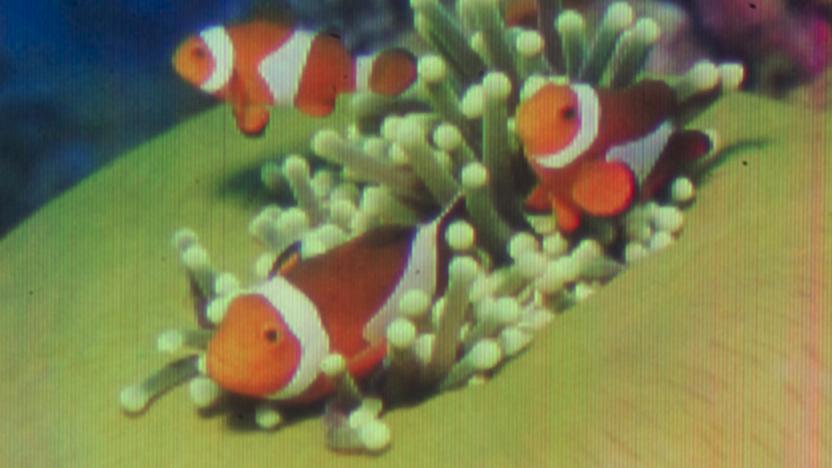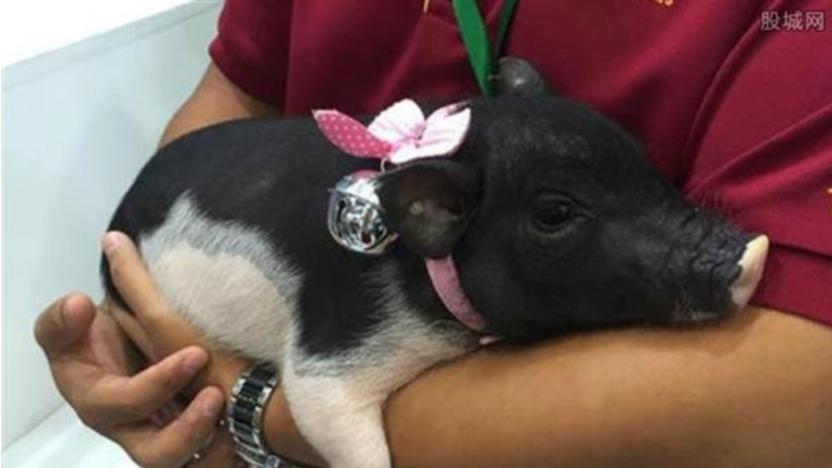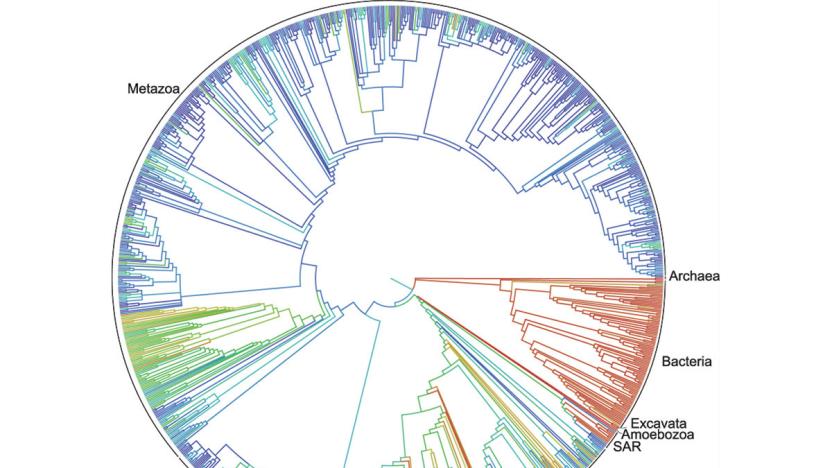biology
Latest

Science: No, you can't be Spider-Man
We hate to crush your childhood dreams, but we have to be blunt: you're never going to be Spider-Man... not without some technical help, anyway. University of Cambridge researchers have determined that wall crawling isn't naturally feasible for any animal larger than a gecko, since you'd need inordinately large hands and feet to support yourself on the way up. If humans wanted to achieve these gravity-defying feats, they'd need sticky pads across 40 percent of their body surfaces -- try making that superhero movie, Sony.

Tiny cameras spy on crows making tools
It's well-known that crows are smart enough to make tools. However, catching that crafting on video is sometimes a big challenge -- unless you lure the birds to a feeding site, you probably won't see the behavior. That's where the University of Exeter is coming to save the day. It recently developed cameras that are small and light enough to sit on crows and record their activity, letting scientists get the first footage of New Caledonian crows making foraging tools in the wild. The cams even have microSD cards and radio beacons to help recover footage when the devices slide off after a few days.

Tiny microscope lets you see the smallest-ever inkjet prints
No, that's not an up-close look at a monitor. That's the world's tiniest color inkjet image made large, and you may not need it blown up to see it in the future -- if you're willing to lay down some cash. In a hybrid of scientific discovery and publicity stunt, Scrona and ETH Zurich have used nano-sized quantum dots to print a clown fish picture measuring just 0.000014 square inches across, setting a Guinness World Record for the smallest color inkjet image to date. You need a good microscope just to see it, in fact... and conveniently, Scrona is working on just that.

Humans are smart because we sleep weird
A new study claims to have learned one of the reasons that humans were able to rapidly evolve beyond rival primates, and it's all down to our weird sleeping patterns. Researchers at Duke University, as reported by the New York Times, believe that our seven-hours-of-straight-shut-eye sleep cycle is something of an aberration. By comparison, chimpanzees enjoy 11.5 hours of rest, but our shorter run enabled us to get a much deeper, more dream-filled snooze. Humans, it seems, have above-average quantities of REM sleep, enabling us to slice valuable hours off the amount of time we're laid up.

Researchers discover the source of animals' natural compasses
For years, biologists have pondered how so many members of the animal kingdom -- from fruit flies and pigeons to sea turtles and wolves -- are able to navigate long distances apparently by sensing the Earth's magnetic field. Two theories have emerged in recent years: one that the ability derived from iron-binding molecules, the other that it came from a protein called cryptochrome. Now a team from China's Peking University have discovered that both theories describe complimentary aspects of the same bio-navigational system.

Stanford scientists get a little closer to a medical tricorder
Being able to identify problems with a person's body without subjecting them to invasive procedures is the fantasy of all Star Trek doctors. There's even a prize offering a fortune to anyone who can effectively recreate the tricorder technology out in the real world. Now, Stanford scientists think that they've developed a system that, in time, could be used to spot cancerous tumors from a foot away.

Researchers use video games to test chameleons' vision
You probably know that a chameleon's eyes move independently of one another. Thanks to video games, however, it's clear that this oddball vision is more powerful than previously thought. Israeli researchers made chameleons play a simple game where they had to track and lash out at multiple digital flies, gauging their ability to focus on two objects at once. In the tests, the lizards easily followed one target in each eye -- they only focused on one fly when they were ready to strike. The eyes even have distinctive movement patterns based on their active roles, so there's no doubt as to what they're doing.

Researchers control fruit flies' hearts with a laser
Scientists have directly controlled animals before, but these approaches tend to either require surgery or only work with critters at certain stages in their lives. Researchers might have a more powerful technique in store, however: they've managed to control fruit flies' heartbeats through laser pulses. The approach relies on optogenetics, or modifying the genes of animals to produce materials that respond to light. In this case, the team tweaked flies' heart cells to produce light-sensitive proteins. After that, it was just a matter of zapping the hearts to make them beat on command, whether the flies were larvae or full-grown insects.

Chinese firm wants to sell you genetically modified pet pigs
The concept of buying pets with custom genes may soon become a reality. Beijing Genomics Institute has divulged plans to sell genetically modified pigs whose DNA will keep them small, weighing in at a modest 31 to 44 pounds. The tweak was originally meant to produce ideal subjects for disease modeling research, but the healthy first generation is reportedly well-suited to pet buyers who don't want large hogs in their living rooms. While it's too soon to know exactly how long these "micro pigs" will live, they're expected to last 15 to 20 years.

Computer Science is the most popular major for women at Stanford
Stanford reportedly has 214 female students enrolled in its Computer Science major -- that's 30 percent of the major's total enrollment -- making it the most popular major with women at the university for the first time. Women constitute 49 percent of the school's total student body and Computer Science accounts for 20 percent of the university's total enrollment. Computer Science did just barely eke out the previous title-holder, human biology, for the top spot by a mere six students.

Self-assembling material could produce artificial veins
Most attempts at creating artificial veins don't come close to replicating organic processes, but researchers at the Queen Mary University of London might change that. They've developed a technique that makes proteins and peptides self-assemble into tubular shapes that could stand in as arteries, veins and similar structures. There's no 3D printing or moulds involved -- you only need to guide the material as it builds itself. It can even grow and heal, so you're not stuck if it needs improvements.

Researchers draft the first comprehensive tree of life
It's very poetic to talk about a tree of life, where every species can trace its roots, but actually illustrating this tree is no mean feat when Earth has been home to at least 2.3 million known species. However, scientists have finally given it a shot. They've published the first draft of a comprehensive tree of life that shows every major evolutionary branch, ranging from the very first organisms to complex beings like humans. This isn't a complete tree, of course (it's doubtful that we'll ever know all the species that ever existed), but it beats the patchwork from before.

Researchers make a living circuit out of bacteria
Under the right circumstances, bacteria can be quite cooperative -- both with each other and the organism they're living in. A research team at Rice University has managed to exploit that natural congeniality to, for the first time, create a biological circuit that works much like a conventional computer chip. But the goal of the researchers' work isn't to build better biocomputers, it's to help them more fully understand how these organisms interact within our guts.

Big Data VR app allows researchers to 'browse' genomes
Earlier this year, Epic Games (the folks that made the Unreal Engine) held a $20,000 competition that challenged VR companies to create programs that could help users better tackle the valuable, albeit unwieldy, figures in Big Data sets. For its entry into "The Big Data VR Challenge" Hammerhead VR submitted The Genome Browser, a virtualization that will allow researchers to, quite literally, browse through an organism's genome and access a library of data (generated by the Wellcome Sanger Institute) at each gene.

Researchers inject oil into cells and create little lasers
The Massachusetts General Hospital research team that lit up human cells with the help of jellyfish genes a few years ago are back with a more advanced version of the technology. This new version forgoes the complicated external mirror setup in favor of injectable oil droplets impregnated with fluorescent dye. This is the same basic idea as what a team from St Andrews University recently created, except that the plastic bead that served as the their laser's resonating chamber is now an oil droplet. While the technology isn't ready for therapeutic applications just yet, it does hold a great deal of promise. The problem with conventional cellular markers and dye is that they have a broad emission spectrum which can make it difficult to spot the marked cells amidst the rest of the tissue. But with these miniature lasers, doctors will be able to mark and track individual cells no matter where they are in the body. The team recently published their findings in Nature Photonics.

Scientists implant teeny, tiny lasers into human cells
A few years back, a pair of researchers at Massachusetts General Hospital made human cells glow by impregnating them with a molecule that's normally found in jellyfish called green fluorescent protein (GFP) and packing them into a resonant cavity that amplified the amount of light each cell produced. Now, according to a new study recently published in the journal Nano Letters, a team of scientists from the University of St Andrews have developed a means of making individual glowing cells also act as their own resonant cavities.

Scientists turn to crowdfunding to safeguard black rhino DNA
Crowdfunding isn't just useful for getting clever inventions off the ground... it could also save an endangered species from fading into oblivion. Scientists have successfully funded a project that will sequence the genome of the black rhino, only 5,055 of which live in the wild. The public-backed effort will improve our understanding of how these iconic animals work, and should lead to synthetic horns that discourage poachers. It could even lead to resurrecting black rhino subspecies that are already extinct. It'll be a while before you see the results, but they'll be available to the public -- that small amount of backer money could do a world of good. [Image credit: AP Photo/Sayyid Azim]

Scientists work out how to wire up your brain
Imagine a future where neurological disorders are cured with a single injection into the top of your skull. That's the expectation placed on the shoulders of Charles Lieber, a Harvard chemist who has developed a groundbreaking technology that has the potential to change medicine. The process involves building a tiny fishing net out of conducting threads that can support microscopic sensors across its surface. It's so small that you can use a regular-sized but stronger needle to inject it via a tiny drill hole straight onto the brain. Then, this mesh begins to unfurl and sit on the top of your noggin, shifting around as your grey matter does normally.

A drop of blood reveals almost every virus you've ever met
This stock image is just for illustration, you do not need this much blood to take the new test. Every disease that you've ever encountered is cataloged within your DNA, and now a team from the Howard Hughes Medical Institute has worked out how to access that data. It's part of a project called VirScan that, it's hoped, will revolutionize medical testing and help Doctors catch illnesses long before they manifest. Even better, is that it's not even an expensive procedure, with each test slated to cost just $25 -- well, at least before your hospital slaps on their own fee on top.

Scientists are one step closer to growing replacement limbs
If the goal in medicine is to be able to repair people as if they were made out of Lego, then we just took a big stride towards that future. A team at Massachusetts General Hospital has managed to grow a rat's forearm that, theoretically, could open the door to whole-limb transplants. The team, led by organ regeneration expert Harold Ott used a technique called decel/recel, which has already been used to grow hearts, lungs and kidneys within the confines of a petri dish.


